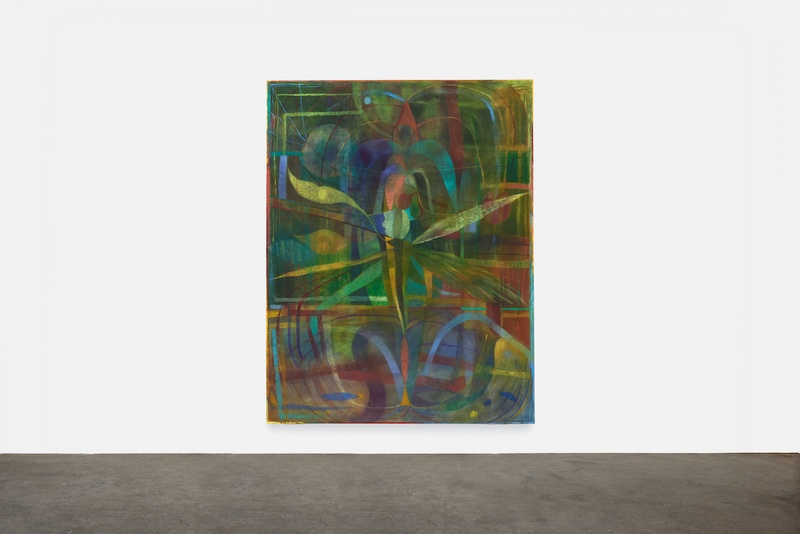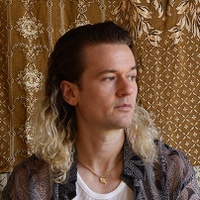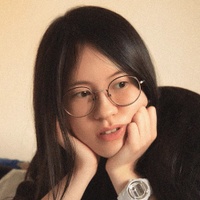On making the time to create
Prelude
Maja Ruznic (b. 1983, Bosnia and Herzegovina) fuses personal narrative, psychoanalysis, mythology, and esoteric thought into vivid paintings that hybridize figuration and abstraction. Painting variably with oils and gouache on immense and small scales alike, she extracts order from layers of diluted pigment. Ruznic’s practice is informed by her studies, from Slavic shamanism and alchemy to Jungian psychoanalysis and sacred geometry. Imbued with a discordant beauty, her compositions emerge without a premeditated outcome. Ruznic’s introspective, mystical approach places her into a lineage of visionary painters including Paul Klee and Hilma af Klint. Ruznic lives and works in Placitas, New Mexico.
Conversation
On making the time to create
Maja Ruznic on embracing physical activity, the benefits of giving up the hustle, and carving out the space you need to do your work.
As told to Claudia Ross, 2748 words.
Tags: Art, Day jobs, Process, Anxiety, Beginnings.
There’s a holy aspect to your work. I’m curious what rituals, either in the studio or outside the studio, you use as a way of entering that space.
I was an athlete most of my young adult life. I ran track and field and cross country for UC Berkeley. So physical movement is huge, and it’s just changed from being competitive to being a more unifying endeavor. I find that there is something ancient and true about having a body that has done something strenuous for 30 minutes to an hour, whether it’s running or hiking or yoga. I do feel a calmness and a unification, like the brain is attached to the body rather than being these two separate entities. So I usually start my day with about an hour to two hours outside, hiking. And then I do short meditations. Nothing extensive, just 10 to 15 minutes.
I also do a lot of active imagination, which is something that Carl Jung developed, which is a bit more visual than meditation. But active imagination is watching images arise in your body and letting them lead the way.
And then I spend a couple of hours working small on gouache. I sit down and there’s something about working with water really small that makes me go really inward. So I go from oxygenating the body and being in touch in that way to then really turning inward. Then after that I go to the big paintings.
So it’s this whole process. My husband, Josh Hagler, and I are both artists and we take turns having really long studio days. So today I have 12 hours in the studio. And then on our short days, which is what I had yesterday, I have seven hours. Which is not bad, but I can’t be as luxurious on those days because I have to take my kid to daycare, come back.

The Arrival of Wild Gods, 2022, oil on linen; in three parts, 100 × 76 inches; 254 × 193.04 cm (each), 100 × 228½ inches; 254.00 × 580.39 cm (overall)
Is that a way of balancing childcare and work?
Yes. Before this, we each had nine hours every single day, but we’re always reevaluating like, “How are you doing in the studio? Do you feel like you can be a true artist or do you feel like the mother, father creeps in too much?” And we landed on the 12-hour day every other day as a way to allow us to forget that we’re a parent for a little bit. Then on that day, the person who has a long day just drops her off, and they don’t have to be back in the house till 7:00PM.
So you don’t have to pick her up, you don’t have to take her to the park, you don’t have to feed her. The short day person does that. But then each of us gets a turn to feel like we can be an artist. Not that you’re not a real artist on the short days because you still have a good chunk of time, but carefree. You don’t have to be responsible. You can just lose yourself.
You describe these roles—mother, father, and artist—as separate spaces, or at least needing their own separate spaces in your and Josh’s lives. Was that difficult to get to or did that division emerge naturally?
Mila, our daughter, is three, and I would say that it took a long time. The first year was really hard. It was the pandemic. She was born in 2020 and I was working on my first institutional show. I was asked to do a solo show at the Hayward Museum in New Mexico when I was four months pregnant, and I had to figure out how to keep painting with non-toxic materials. And then she was born and I had postpartum depression.
It was the beginning of the pandemic when she was born, a total shutdown. And I have to say, that is awful for a parent who just had a baby. We had no idea what we were doing. So yes, this routine was something we earned, I’d say.
Motherhood was a central theme of the painting in your most recent show at Karma in LA. Do you feel like being a parent influenced the things you were interested in painting?
Well, the mother motif has been something that I’ve been interested in for a long time. I think it started out with my own interest in my relationship with my mother, an immigrant refugee who sacrificed her entire life to bring me to safety. She abandoned her own livelihood in a way, to sacrifice herself for me.
And then becoming a mother myself influenced me even more, because I saw how difficult it was for me to actually accept the identity of mother. I actually really didn’t like it and I didn’t know that about myself beforehand.
I wanted to become pregnant. I was in a privileged position where my husband and I chose to have a kid, and then we worked on having a kid. Everything was so thoughtful and I thought that, “Well, as long as you’re thoughtful and mindful and intentional, everything will work out.” Well, I did it all that way and then the child came and I was like, “I hate this. I don’t want to be a mom.” Because I felt robbed of my artist persona.
So it was really an identity conflict thing. When Mila was born, it felt very either/or, very binary. You’re either an artist or a mother, and I felt the suffocation of motherhood, squeezed out of all life force. But it didn’t do that, at all, because I made this whole show while I was pregnant. You realize how much you make these traps in your own mind.

The Past, the Present and The Future in the Chest of One Man, 2023, oil on linen, 100¼ × 76⅛ inches; 254.63 × 193.37 cm
I think that our understanding of the artist as containing multiple identities is really new. It’s a constant negotiation. I hope that it’s easier for your daughter’s generation.
I think it will be. I mean, she’s already growing up seeing her dad do things that I feel like I never got to see. I think so much of our idea of what life can offer has to do with what we see when we’re growing up.
You moved to New Mexico somewhat recently, but before that you moved around a lot in California—and you moved from Bosnia in 1992. How did those moves influence the painting you were interested in making? How did it influence your formation as an artist?
I pull so much of my stuff from my subconscious, so I always thought that it doesn’t matter where I am. But I’ve since learned that your environment affects your subconscious. My work that I was making in LA was very different than the work I started making in New Mexico. We moved here in 2017, and I had Mila in 2020. And the reason why we moved to New Mexico was because my husband and I were both having a really hard time making ends meet in LA.
Then my husband received the Roswell Artist Residency Program, and it was a year long. I came with him and they treated me really nicely. They gave me a studio too, and we didn’t even think we would stay in New Mexico, but we just fell in love with this land.
I suffer from a lot of anxiety, and I noticed that my anxiety was better here. I know a lot of those transcendental artists moved here for the air, to help with tuberculosis. There is something about the southwest that artists have been attracted to in a healing way.
Did you find there was some freedom in moving from LA? Or was it difficult to be more remote from that part of the art world?
When we left LA, we were both so tired from the hustle. We had no money. We rented a Penske truck on my credit card that we didn’t know how we would pay back. It was such a difficult time for us just on a survival level. We tried to do the artist thing in San Francisco, and then LA, and it didn’t work.
When we moved to Roswell, we had already given up on trying to make it. And it was in that giving up that everything became larger. We got larger studios that we didn’t have to pay for. And strangely, that was when the world started noticing us. For both of us, things started moving. We just had the time, too. It was the first time in my life, at 36, where I was a full-time artist.
Wow.
Before then, I had various jobs in LA just to pay my rent for my tiny studio. I was clocking in 10 to 15 hours of studio time a week because I had to work. I went from that to 60 hours a week. I mean, there’s something just really important about having that time. I could actually be an artist in a cheaper place.
I have spoken with a lot of artists who work a day job, and some of them say that having a day job gives them stability. But I think people struggle to talk about the other thing, which is that having a lot of time is actually really beneficial to developing a practice, to developing work.
Especially with painting. I hate to sound like an old person, but you’ve got to put in your hours. 15 hours of oil painting a week is not going to cut it. You can’t fake it with oil painting. You have to be a great painter if you want to be noticed. It’s such an unforgiving material. And I do believe that the mastery of material that comes only with putting in your time.
I actually love working, too. I could be in the studio 12 hours, maybe not painting every single second, but I have my yoga mat in here so I’m stretching and looking at what I’m working on. Sometimes you just need three hours of looking at what you’ve been working on last week. Whereas, if you’re rushing and then trying to get to your day job, you can’t do that.

Holographic Anxiety Propeller, 2023, oil on linen, 90⅛ × 70⅛ inches; 228.93 × 178.13 cm
There’s something that’s so difficult, especially when you’re in that space of trying to make ends meet as an artist, to separate from the idea that you’re wasting time if you’re not literally producing something. But it’s true that you need to be able to think about the work, in addition to the time spent actually painting.
Totally. I had a long period of struggle, but I’m glad I didn’t become an art star in my 20s. I can’t imagine having all these resources at 20. Again, I sound super old school in this way, but I do believe in earning things and struggling and knowing how to respect it and not take it for granted.
I think that you see a lot of people that do get all of those resources really young, and they get a lot of attention, and they get stuck in a certain mode of creating—whether that be a certain aesthetic or practice. Eventually, everyone reaches those difficult moments in a career. I think a lot of people struggle to get over those periods if they had a lot of recognition early.
Absolutely. And I mean, everyone has their own path. I think the work I’m doing and the person that I am—it was never meant to blow up at 20. I would like to think that I’m making work that feels timeless and that it has a soulfulness that you cannot have at 20. And I feel it’s okay to say this, because we already live in such a youth-obsessed culture. We’re so death-averse and aging-averse. As a result, we lose out on so much wisdom that only comes from being alive for a long time.
I’m not making work that’s really commenting on social issues or reacting to events. I feel I’m making work that hovers right outside. I’m observing and absorbing all of it, but I’m not interested in any form of reaction because I feel my art’s purpose is to exist on a different timeline than the one that you and I operate in.
I do see lots of alien, spectral figures in your painting. There’s almost a fantasy element to your work. I’m curious how you tap into that other realm that’s not entirely human.
When I was little and my mom and I were in the first refugee camp in Austria, I was between 9 and 10. And when you’re a kid and there’s conflict, and you have to flee, things start feeling a little—otherworldly, Lynchian. There’s fear for sure, but there’s also excitement. You’re meeting new kids all the time. There’s no curfew. We would sleep in the same big room.
And during that period of time I had something that I call my sandbox moment. I was outside and there was a little sandbox and it was a really warm summer day at the camp. I remember feeling the sand and rubbing it on my thighs and looking up at the sky. I was not raised with any religion, but I could feel the voice of God saying, “You will be okay.” I didn’t go and seek the holy, but it found me in that sandbox.

The Split/The Beginning, 2023, oil on linen, 100¼ × 76¼ inches; 254.63 × 193.68 cm
So I trace [my painting] all the way back to that, because that was my entry into another realm. The sensation of the cosmos made me feel safe. Something inside of me was turned on like a button. In psychoanalytic theory, they often talk about how trauma can be the onset of visionary thinking. I’m really interested in trauma as this two-pronged thing, where it’s both painful and an enormous gift. After that I started painting a lot, and I was always very expressive. I wrote a lot of poetry as a kid. I was very sensitive.
I was always into sports too. I liked feeling things deeply. I loved feeling my heart beating and the sweat. It was different than other kids, because for them it was like, “Let’s go win.” And for me, I was like, “But do you feel your heart beating?” So even my relationship to running was really spiritual. After a long run, I would feel connected to God or something.
The sandbox moment that you describe is so interesting because it also involves a physical or creative act, like painting. And that physical act is what activated this very spiritual encounter.
I think about that sandbox moment a lot. And just in terms of whether or not I would’ve had it if the war never happened. I’m definitely not romanticizing war, but I’m interested in what grows out of war, both the good and the bad. And that sandbox moment was a strange side effect of the war.
We’ve talked a lot about how your practice has evolved to the state that it’s in currently. Where do you see your creative life moving in the future?
I would really love to work on a play. I just really want to make something super immersive, where music is involved or sound effects. I want the senses to be flooded with awe. I am interested in how restorative it is to be in awe. I would just love to create some play that’s non-linear. A play that feels like a painting. That’s where I see it going.
Maja Ruznic Recommends:
Try to always be reading a book that changes the way you see the world
Movement/dance
At least 1 hour of solitude every day
Baths
Delicious food
- Name
- Maja Ruznic
- Vocation
- visual artist
Some Things
Pagination



